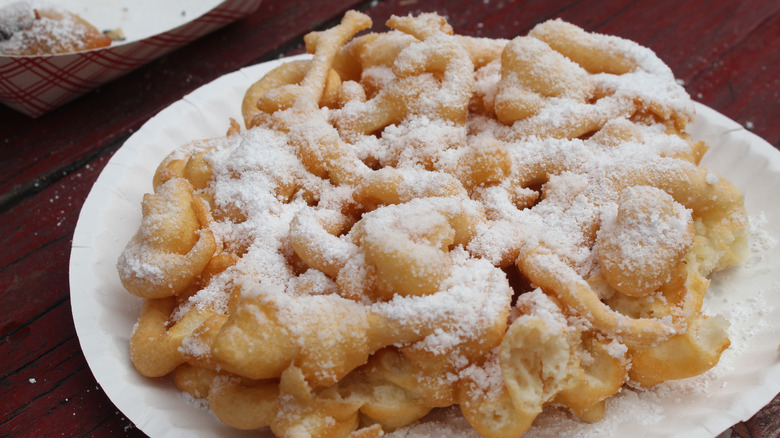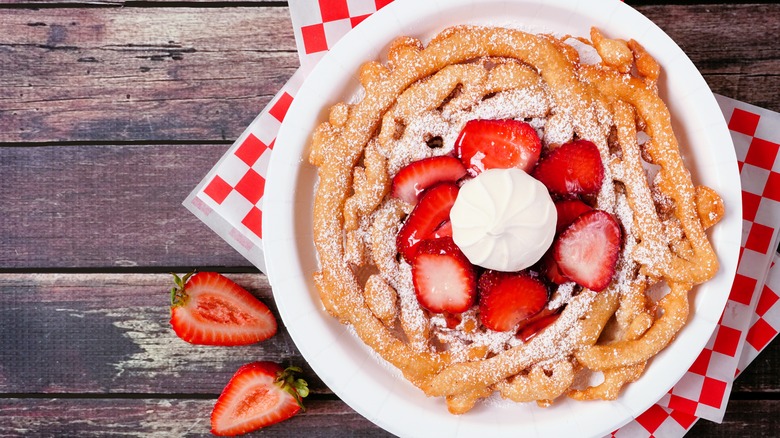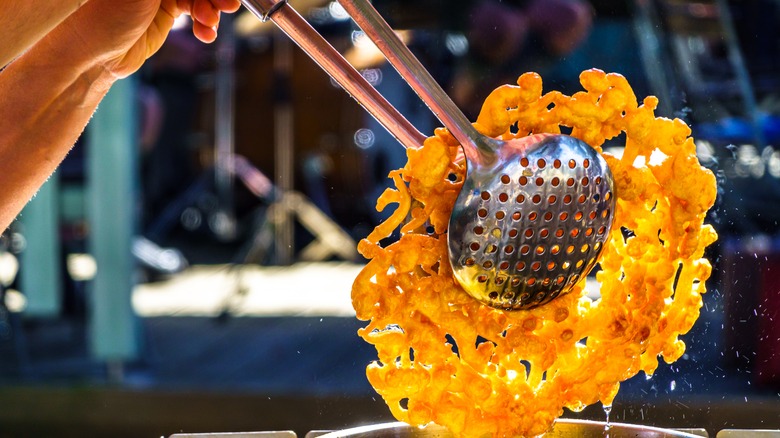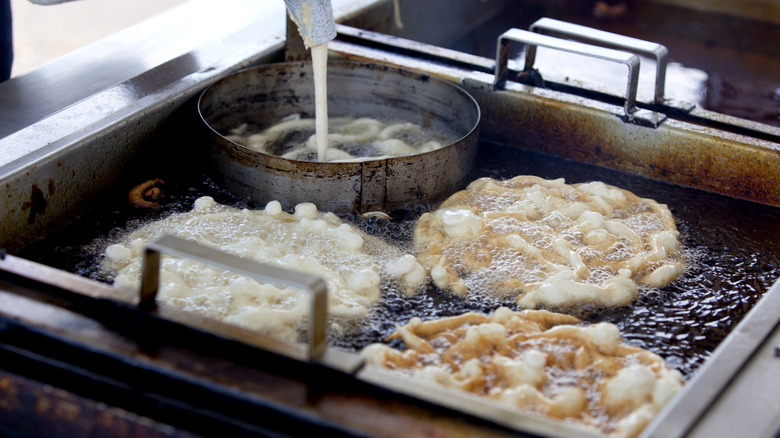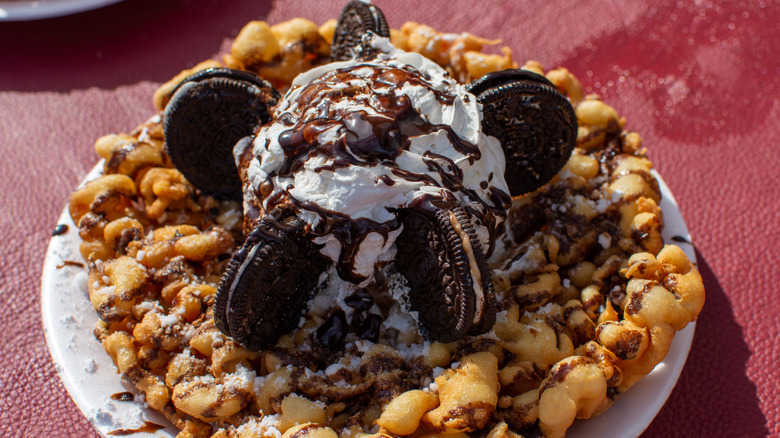Funnel Cakes: What Are They And How Do You Nail The Batter?
Fairs are truly a feast for the senses, from the sound of the bands performing, to the sight of the rides' colorful lights at night, and the smell of fair foods, perhaps none better smelling than the aroma of freshly fried funnel cakes filling the air. While a ubiquitous carnival and fair food, funnel cakes are also popular along boardwalks and at outdoor music festivals — really anywhere a fun, easy-to-eat food is appropriate. Share with a friend and rip off pieces of the spiral funnel cake, or keep the whole treat for yourself, but make sure to grab extra napkins because this treat can get a little messy (which is half the fun).
Served warm and most often covered in powdered sugar, funnel cakes have a crispy fried exterior and a soft, fluffy interior. With some vendors solely dedicated to making and selling the treats, the toppings can get fairly elaborate. After all, what's a fair without an over-the-top treat?
History of funnel cakes
Like many of America's favorite snacks and treats, funnel cakes were popularized by the Pennsylvania Dutch, a group of German immigrants. However, while the Pennsylvania Dutch may have shared their love of the fried dough treat in the U.S., similar dishes were made hundreds of years ago in the Middle East and Europe. Versions of fried dough eaten during Medieval times were called "mincebeck" in cookbooks, likely coming from the French "mise en bec", which can be translated to "put in spout." Just like in modern times, the dough was poured into hot oil to fry with a kitchen tool.
Centuries later, German immigrants brought with them a dessert called "drechter kuche" to the U.S., which was made by pouring dough with a funnel into the frying oil, and is the predecessor of today's funnel cake. While the German treat was a favorite for many people, it didn't become a popular fair food until the mid-20th century when the Kutztown Folk Festival in Pennsylvania was started. First held in 1950 by a group of professors who wanted to celebrate Pennsylvania's heritage, funnel cake was served to hungry festival-goers. From there, the popularity of funnel cake and its appearances at festivals, fairs, carnivals, and outdoor events only increased.
Batter made with staple kitchen ingredients
With the funnel cake, it's all about the dough. Too thin and the dough will not shape up properly in the frying oil. Too thick and it won't spread evenly and the cook will be inconsistent. It could even be overdone in one area while underdone in another section, making for an inedible treat.
While you can use store-bought pancake mix, making funnel cake batter from scratch is easy and requires ingredients that you likely already have on hand. Flour, unsalted butter, water, sea salt, granulated sugar, and eggs are all that are needed for a hearty batter that is fried in canola oil. Vanilla extract is also a commonly used ingredient. Some recipes call for 2% milk and baking powder to be mixed in.
If opting for a pancake mix to start the batter, additional ingredients are needed, but it depends partly on what mix is used. You can use a buttermilk pancake mix and add sugar, vanilla extract, and water to make a funnel cake batter. Other mixes may need to be combined with milk and eggs.
A funnel is not essential
After making the batter with a hand or stand mixer, it needs to be placed in a funnel or a piping bag to be poured into the oil for frying and to give the treat its signature look. If looking for more control over how the dough is placed in the oil, a piping bag is a good way to go. Even an empty squeeze bottle, such as a ketchup bottle, can work, as well as a measuring cup. There is a bit of an art when it comes to crafting a funnel cake. If using a piping bag, a round tip up to ¼ inches in diameter is recommended. The dough should be squeezed into the hot oil in a zigzag or spiral shape for a traditional funnel cake look. Don't overcrowd the oil.
Once the batter has been dropped into the hot oil, funnel cakes should be fried for about 3 to 5 minutes or until golden brown and puffed up to triple their original size. While frying, the cakes should be flipped over about every 30 seconds. After being removed from the oil, the cakes should be allowed to cool a little bit on a rack on a plate covered with a paper towel. Then, the cakes can be finished with powdered sugar or other toppings and served warm.
Fun with toppings
While the traditional way to serve funnel cake is with powdered sugar, the sky is the limit in terms of what has been found on funnel cakes at fairs. For something sweeter, whipped cream and a drizzle of Nutella can't be beaten. For an all-out dessert, add a scoop or two of ice cream, even hot fudge or caramel syrups, and Maraschino cherries.
With a coating of cinnamon and granulated sugar, a traditional funnel cake can be transformed into a churro funnel cake. Consider serving with dulce de leche sauce for extra sweetness. Also consider fresh ingredients such as strawberries, peaches, raspberries, or other fruits, and homemade whipped cream for cake toppings. Canned fruit topping can also be used for a pie-like flavor, as well as a fruit sauce.
Should there be leftover funnel cakes (not likely), put them in an airtight container and refrigerate until later. To reheat, placing it in the microwave is fine if a soft funnel cake is wanted. Otherwise, for a crispier funnel cake, heat in the oven or toaster oven. Funnel cakes can also be frozen and eaten later. Simply allow them to come to room temperature, wrap them, and then store them for up to three months.
No matter how you eat your funnel cake, remember to have fun, because just like the fair, a funnel cake isn't meant to be taken too seriously.
